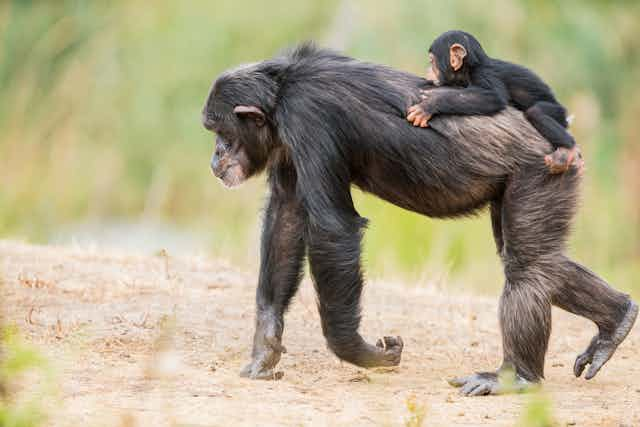The chimpanzee is our closest living relative, and it could be facing extinction. There were one million chimpanzees in 1900, but today, 300,000 at most are thought to remain in the wild.
Prime African rainforest habitat is being broken up by loggers and poachers, and dried out by climate change. Habitat loss robs species of food sources and nesting sites, but it also prevents individuals moving between the remaining habitat, leaving populations isolated and in danger of inbreeding. To reverse the fragmenting of habitats, scientists often try to restore and expand green corridors of fast-growing trees between the remaining patches, to encourage animals to keep moving and stay connected.
Understanding how chimpanzee habitats linked up in the past can help scientists identify the priority areas for chimpanzee conservation today. But chimpanzees have the widest range of any great ape species. How can we spread our efforts efficiently to find these areas across the broad swathe of rainforest, woodland and savanna they occupy? In western Tanzania alone, chimpanzees range across 20,000 square kilometres. We could try to track their movements by fitting several apes with radio-tracking devices, but this would mean trapping and sedating lots of different animals.
Instead, we tried something a bit more innovative. In a new study, we used a concept from electrical engineering to spot connections between clumps of chimpanzee habitat that could be reinforced to help the species recover.
Circuit theory for chimpanzees
Let’s pretend you’re hovering above western Tanzania. But instead of seeing a vast landscape, imagine you’re looking at a circuit board. Imagine an electrical current is flowing between the different components before you. The chimpanzees are the electrons in that current, and they can pass more easily within bits of intact forest. Engineers describe parts of an electrical circuit where electrons can pass more easily as having a low resistance value. Meanwhile, there are parts of the circuit with a high resistance value which act to slow down the flow of electrons. In our landscape analogy, these are the areas where chimpanzee movement is slowed by barriers, such as roads and large rivers.
This is called a landscape connectivity model. It grades particular habitats visible in satellite images according to how well chimpanzees are likely to be able to traverse them, allowing us to map and predict connectivity between chimpanzee habitats over time. That’s important, as deforestation can rapidly degrade suitable habitat. Satellite images from 1973 to 2019 reveal how some forested areas with low resistance to animal movement have become more resistant as logging has continued.

Our model revealed a series of corridors connecting an 18,000 square kilometre ecosystem. These corridors appear to have become more resistant to chimpanzee journeys over time due to the destruction of 1,677 square kilometres of forest between 1973 and 2018.
The model also helped correct an old misconception. When 50,000 refugees from Burundi arrived in the region in 1973, a vast area of woodland was cut down so they could grow food. We assumed this had punched a hole in habitat that connected the northern and southern populations. But actually, by comparing maps from before and after the refugee settlement was established, we realised that the cleared forest was never likely to have been suitable chimpanzee habitat.

Most importantly, our results identified priority areas for chimpanzee conservation. This is where conservationists and government institutions should channel investment and focus protection efforts, whether it’s restricting settlement expansion, increasing patrols and surveillance, or boosting community outreach and education.
Wildlife species are becoming increasingly isolated in landscapes that are dominated by humans, and it’s up to conservationists to discover how to reconnect their lonely patches of habitat. Our results show it can be done with just a fraction of the time and resources using landscape connectivity modelling.
The method has already been used to support the conservation of reptiles, birds and some small and large mammals. Now, we’ve confirmed it can work for one of nature’s most behaviourally complex and wide-ranging species, the chimpanzee. As the accessibility and resolution of satellite imagery improves, we can use this method to help us make the right decisions at the critical moments, safeguarding the extraordinary biodiversity of our planet.


